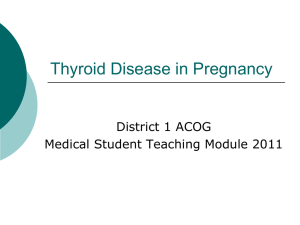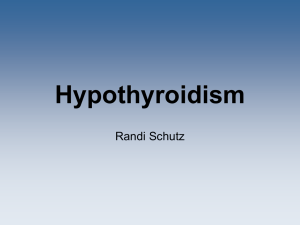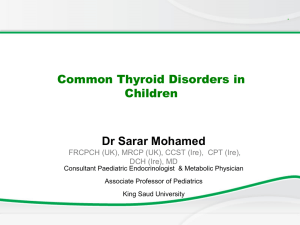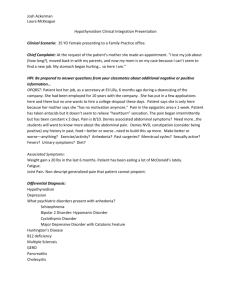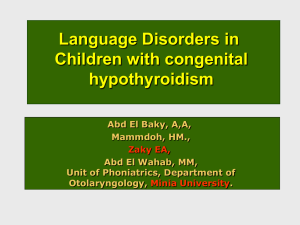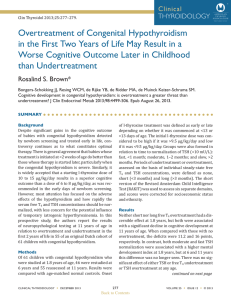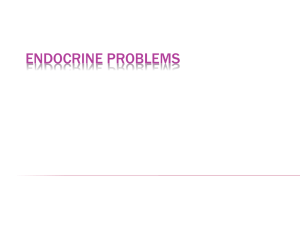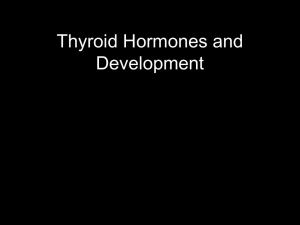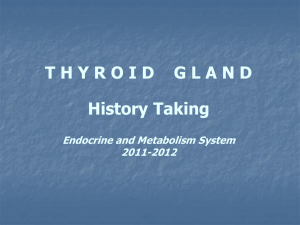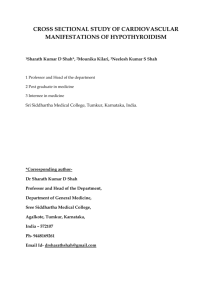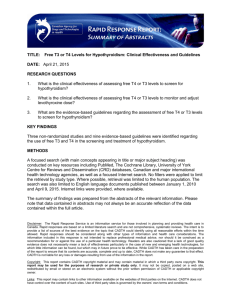ABSTRACT Objective : To determine the incidence of congenital
advertisement
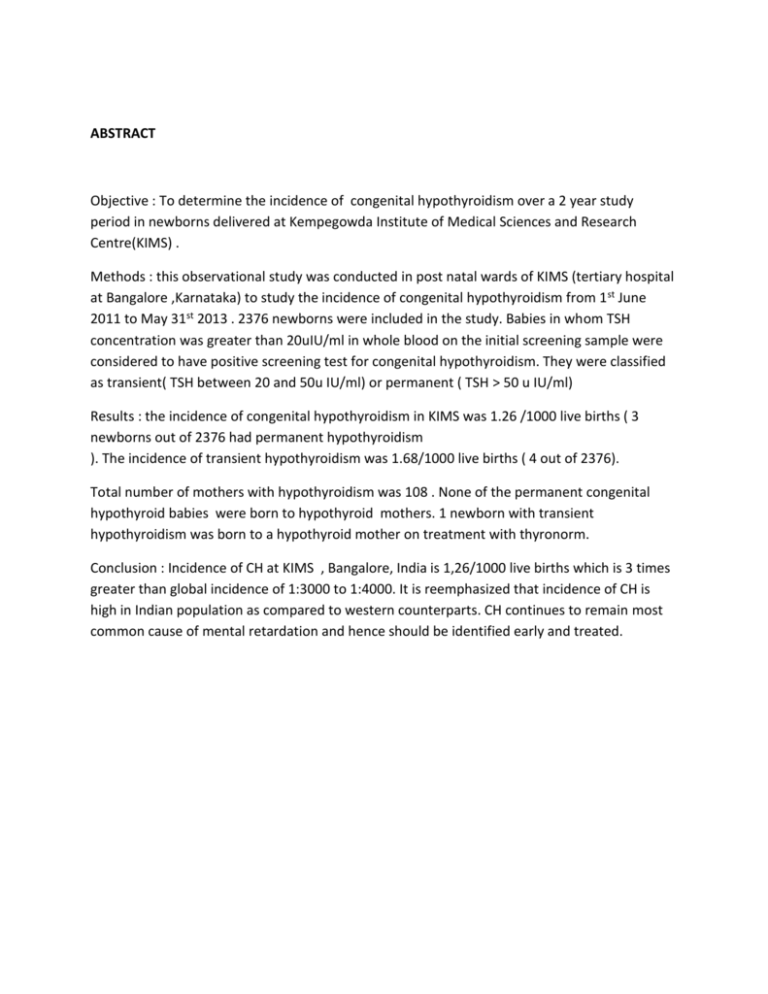
ABSTRACT Objective : To determine the incidence of congenital hypothyroidism over a 2 year study period in newborns delivered at Kempegowda Institute of Medical Sciences and Research Centre(KIMS) . Methods : this observational study was conducted in post natal wards of KIMS (tertiary hospital at Bangalore ,Karnataka) to study the incidence of congenital hypothyroidism from 1 st June 2011 to May 31st 2013 . 2376 newborns were included in the study. Babies in whom TSH concentration was greater than 20uIU/ml in whole blood on the initial screening sample were considered to have positive screening test for congenital hypothyroidism. They were classified as transient( TSH between 20 and 50u IU/ml) or permanent ( TSH > 50 u IU/ml) Results : the incidence of congenital hypothyroidism in KIMS was 1.26 /1000 live births ( 3 newborns out of 2376 had permanent hypothyroidism ). The incidence of transient hypothyroidism was 1.68/1000 live births ( 4 out of 2376). Total number of mothers with hypothyroidism was 108 . None of the permanent congenital hypothyroid babies were born to hypothyroid mothers. 1 newborn with transient hypothyroidism was born to a hypothyroid mother on treatment with thyronorm. Conclusion : Incidence of CH at KIMS , Bangalore, India is 1,26/1000 live births which is 3 times greater than global incidence of 1:3000 to 1:4000. It is reemphasized that incidence of CH is high in Indian population as compared to western counterparts. CH continues to remain most common cause of mental retardation and hence should be identified early and treated. INTRODUCTION CH is the most common preventable cause of mental retardation.1 Global incidence is 1:3000 to 1:4000 live births , the incidence being higher among Asian and Hispanic children. Indian incidence is 1:1757. Normal male: female ratio is 2:1. 2 The commonest etiology are thyroid dysgenesis ( aplasia, hypoplasia , ectopics ) and dyshormonogenesis. Thyrotropin receptor blocking antibodies, maternal medications, iodine deficiency, genetic mutations are other causes.3 Over 95% newborns with CH are asymptomatic at birth but universal newborn screening allows for early diagnosis and treatment resulting in optimal neurodevelopmental outcome .Some may present with mild symptoms that often go unrecognized as a problem like excessive sleeping , reduced interest in feeding , poor muscle tone , low or hoarse cry , infrequent bowel movements and low body temperature . A small percentage of babies have clinical features of low hairline , thick scalp , wide open anterior fontanelle , eyes far apart with depressed nasal bridge , macroglossia , apnoeic episodes , umbilical hernia , RDS , and prolonged jaundice . 4 This new born screening is currently not being performed in many developing countries .And in India it is still in its nascent stages due to poor infrastructure and economic constraints. In some countries like UK, T4 is measured followed by TSH when T4 is low. Some projects measure TSH as the primary screen.5 In our study we have done both screening T4 and TSH. CH can be permanent( > 50u IU/ml) or transient ( 20 to 40 u IU/ml) Causes for transient hypothyroidism are antithyroid drugs ,iodine excess ,iodine deficiency ,TSH receptor blocking agents and transient hypothyroxinaemia of prematurity.3 Global incidence of maternal hypothyroidism in pregnancy is - overt ( 0.3 to 0.5 % ) or subclinical ( 2 to 3%) . The most common causes of maternal hypothyroidism in iodine sufficient areas is chronic autoimmune thyroiditis .Other causes are previously treated graves , thyroid CA, drug and external radiation induced hypothyroidism and pituitary dysfunction. 3 Associated adverse fetal and neonatal outcomes includes preterm birth , IUGR ,congenital anomalies ,fetal distress in labour and fetal and perinatal deaths. However these complications are avoided with adequate treatment of hypothyroidism ideally from early pregnancy .Affected fetus may experience neurodevelopment impairments , particularly if both the fetus and the mother are hypothyroid during gestation.6 MATERIAL AND METHODS This observational study was conducted over a period of 2 years from June 2011 to May 2013 .This study was approved by institutional ethics committee. All babies delivered at KIMS in the stipulated time period were included . The exclusion criteria were 1) babies weighing <1.5 kgs - VLBW( to exclude transient hypothyroxinaemia of prematurity) 2) babies in whom exchange transfusion was done in first 3 days 3) genetic defects.3 On day 1 of baby, detailed head to toe examination and systemic examination was done and entered in case profiles. On day 3 ( between 48 to 84 hours ) all subjects underwent T4 and TSH measurements , 2ml of venous blood was withdrawn and analysed using ELICYS. TSH concentration > 20 u IU/ml in whole blood on initial screening sample were considered to have positive screening result .Any abnormal values were repeated with in 3 days .3 Patients were followed up till discharge and further follow up was done in those cases with congenital hypothyroidism. RESULTS Total no of deliveries in the 2 year period 2786 Excluded : 410 -stillborn -VLBW -exchange transfusion done Total no of newborns included in study 2376 -Neonatal death due to any cause TSH > 20 u IU /ml 22 TSH > 50 u IU/ml TSH 20 – 50 u IU/ml 3( 0.126%) 19 Repeat TSH > 20 and < 50u IU/ml 4( 0.168%) Repeat TSH normalized 8 Repeat TSH not done 7 Totally 3 cases had permanent congenital hypothyroidism with M:F ratio of 2:1 , all weighing more than 2.5 kgs. All were born to euthyroid mothers .Baby 1 developed RDS and jaundice and thyroid scan revealed ectopic gland . Baby 2 was a term baby with normal clinical features and thyroid scan showing agenesis of thyroid gland. Baby 3 was a late preterm baby with low hairline and normal thyroid scan. Babies were started on thyronorm , given supportive therapy and phototherapy as per needs. There were 4 cases of transient hypothyroidism with M:F ratio of 1:3 . All 4 were term babies with birth weight ranging from 1.75 to 3.1 kg. 1 baby was born to a hypothyroid mother on treatment with thyronorm. 1 baby had developed jaundice. 2 babies thyroid scan was normal . 2 other babies it was not done ,as attenders did not agree for investigation. SEX SES PERMANENT HYPO M M lower lower OBS HIST THYROID STATUS GA multi Eu thyroid Pre term multi eu thyroid term CLINICAL FEATURES T4 TSH thyroid scan Jaundice RDS 8.0 80 ectopic N 3.14 >100 agenesis TRANSIENT HYPOTHYROIDISM F M F Lower Lower Lower middle primi Primi Primi Eu Hypo Eu thyroid thyroid Late Term Term preterm Low jaundice N hairline 2.64 1.97 6.38 >100 31.45 38.4 N N Not done F lower F Lower primi Eu thyroid Term Primi Eu Thyroid Term N N 19.98 25.32 not done 15.10 38.8 N Out of 8 cases whose TSH returned to normal on repeat testing,6 had jaundice and 2 had poor feeding with sepsis. Total no of mothers with hypothyroidism was 108 and 102 were on treatment with either thyronorm or thyroxine of dose prescribed by medical practitioner. 1 of this mother had baby with transient hypothyroidism . CONCLUSION Incidence of permanent CH at KIMS , Bangalore, India is 1.26/1000 live births which is 3 times greater than global incidences. It is reemphasized that incidence of CH is high in Indian population as compared to western counterparts. CH continues to remain most common cause of mental retardation and hence should be identified early and treated. Adequate follow up strategies should come into place (important to distinguish transient and permanent CH), Newborn screening should be made compulsory in all centers for early detection and institution of treatment at the earliest. REFERENCES 1. Diagnosis and teatment of hypothyroidism , The Indian Journal of Paediatrics , vol 49 , issue 4 , pp 577 – 587. 2. Michael O Ogundele, Mike Waterson,When should we be conducting thyroid function tests in newborns and young infants?.Arch Dis Child 2010 ; 95:151 – 152. 3. Thyroid Disorders , Chapter 3 , Manual of Neonatal Care, 7th Edition, John P Cloherty , Eric C Eichenwald, Ann R Stale. 4. Hypothyroidism , Stephen Lefranchi , Chapter 559,Nelson Textbook of Paediatrics , 19th Edition. 5. UK Newborn Screening Programme Centre Policies And Standards,2005. http://newbornbloodspot.screening.nhs.uk/nat_std_cf_protocol#fileid10968 6. Korada M, Pierce MS, Ward Platt MP et al . repeat testing for congenital hypothyroidism in preterm infants is unnecessary with an appropriate TSH threshold.Arch Dis Child Fetal and Neonatal Ed 2008;93:F286-8. 7. British Thyroid Asoociation. UK guidelines for the use of thyroid function tests . July 2006 http://www.british-thyroid-association.org/info-forpatient s/docs/TFT_guideline_final_version_July_2006.pdf.


